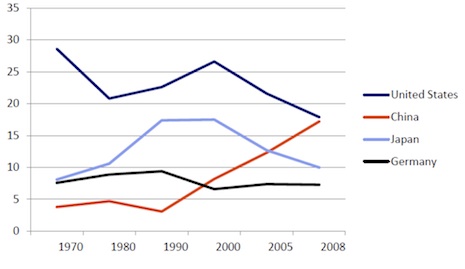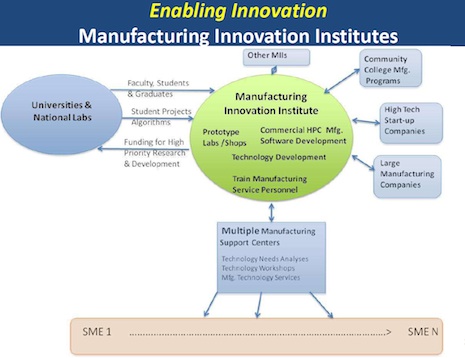AMP: Slow and Steady Wins the Race
 The wheels of government may turn slowly, but at least, sometimes, they turn.
The wheels of government may turn slowly, but at least, sometimes, they turn.
Case in point: On July 17 a report entitled “Capturing Domestic Competitive Advantage in Advanced Manufacturing,” was released by the President’s Council of Advisors on Science and Technology (PCAST).
On September 20, the Wilson Center in Washington, D.C. was the scene of an event convened to discuss the report. It was moderated by Tom Kurfess from the Office of Science and Technology Policy in the Executive Office of the President.
Recently, the Wilson Center sent Digital Manufacturing Report a summary of the meeting. We are pleased to present some of its highlights here. The event was one more step in the implementation of the Advanced Manufacturing Partnership Program (AMP), which President Obama launched on June 24 of last year.
AMP is an important initiative. It brings together the federal government, industry and academia to invest in emerging technologies – like digital manufacturing – that will fuel a resurgence of manufacturing in this country, create jobs, and boost our position in world marketplace. The report contains the final recommendations of the AMP steering committee, which consisted of CEO’s from twelve major U.S. companies and manufacturing firms and six leading U.S. universities.
The September 20 presentations were made by technical co-leads for the AMP Report: Martin Schmidt, Associate Provost and Professor of Electrical Engineering at MIT; and Theresa Kotanchek, Vice President for Sustainable Technologies and Innovation Sourcing at Dow Chemical.

World Manufacturing Output
Schmidt led off the discussion by pointing out that the U.S., the third largest manufacturing exporter in the world, has suffered a steady decline in manufacturing exports, especially since the downturn in 2010 (see chart above).

Employment Trends: Source: Bureau of Labor Statistics, Current Employment Statistics, 1962-2010; www.bls.gov/ces/tables,htm#ee
Manufacturing peaked in 1978 with 19 million jobs in the sector, but between 2000 and 2010 manufacturing jobs plummeted from 17 million to 12 million. Although just about every U.S. state lost jobs, Michigan and North Carolina took an especially heavy beating with 40 percent of the jobs in the sector evaporating.
More unsettling news. Between 1988 and 2008 the U.S. has consistently run a trade deficit in manufacturing products. Schmidt noted that perhaps the most “alarming” trend is that since 2010 the U.S. has shifted from being a net exporter to a net importer of advanced technology products.
He next turned to the topic of research and development investment and noted that “roughly two-thirds of industrial R&D investment is being made by U.S. firms,” including the hiring of scientists and engineers. Problem is, as these firms move overseas as a result of offshoring, the U.S. loses both its domestic R&D investment and jobs. This is particularly true for pharmaceutical, semiconductor and computer companies.
He emphasized the importance of close ties between R&D and manufacturing, referencing Gillette’s plant in Boston and Intel’s extensive semiconductor production and R&D facilities both located in Portland, Ore.
Making AMP Work
The PCAST report defines advanced manufacturing this way: “Advanced Manufacturing involves the manufacture of conventional or novel products through processes that depend on the coordination of information, automation, computation, software, sensing and networking, and/or make use of cutting edge materials and emerging scientific capabilities.”
Theresa Kotanchek used this definition as the context for defining the AMP mission in terms of three objectives:
• Develop a permanent model for evaluating, prioritizing, and recommending federal investments in advanced manufacturing
• Create a recommended initial set of partnership projects to move forward
• Provide additional recommendations to the administration regarding what will drive and support investment.
The report, she said, identified 11 technologies where public/private partnerships should be established. The technologies include:
• Additive manufacturing
• Advanced forming and joining
• Advanced materials design, synthesis and processing
• Advanced sensing, measurement and process control
• Visualization, informatics, and digital manufacturing technologies
• Sustainable manufacturing
• Nano-manufacturing
• Bio manufacturing and bioinformatics
• Advanced manufacturing and testing equipment
• Industrial robotics
To facilitate public/private partnerships, the report recommends establishing Manufacturing Innovation Institutes (MIIs). The rather busy slide below shows the structure of a typical MII.

At this point, Schmidt described how the AMP steering committee addressed the issue of workforce development and priming the talent pipeline. This includes a makeover of manufacturing image to reflect the new emphasis on advanced technology and addressing the skill gap that is occurring as older workers leave the workforce with not enough trained younger people available to fill these jobs. He mentioned using the military’s Transition Assistance Program (TAP) to train returning veterans for these positions. Other recommendations called for investment in community colleges, improved university programs that include manufacturing with degrees at BS, MS and PhD levels, and a system of national manufacturing fellowships and interns.
Kotanchek pointed out that the U.S. needs to improve its business climate to spur growth in advanced manufacturing. For example, this country has the highest corporate tax rate in the world. Also we need smarter regulations, she said, in order to “engage earlier and with better cost analysis, as well as the use of sound science in international best practices to be able to build off of the foundation of the regulatory drivers and standards.”
The manufacturing sector is a large consumer of energy, and consequently, domestic energy policies can have a profound impact on global competitiveness. The AMP Report makes specific policy recommendations regarding energy issues.
In summary, the AMP recommendations are designed to reinvent manufacturing in a way that ensures U.S. competitiveness, feeds innovation, and grows a robust domestic manufacturing base.
According to the report, “The recommendations focus on our future and the opportunity to lead the world in new disruptive advanced manufacturing technologies which are changing the face of manufacturing and in which the inherent strengths of U.S.’s innovation economy can be brought to bear to create new opportunities for making things in America. We – industry, academia, communities and Federal, State and local governments – must unite to ignite our ingenuity to make it in America.”










